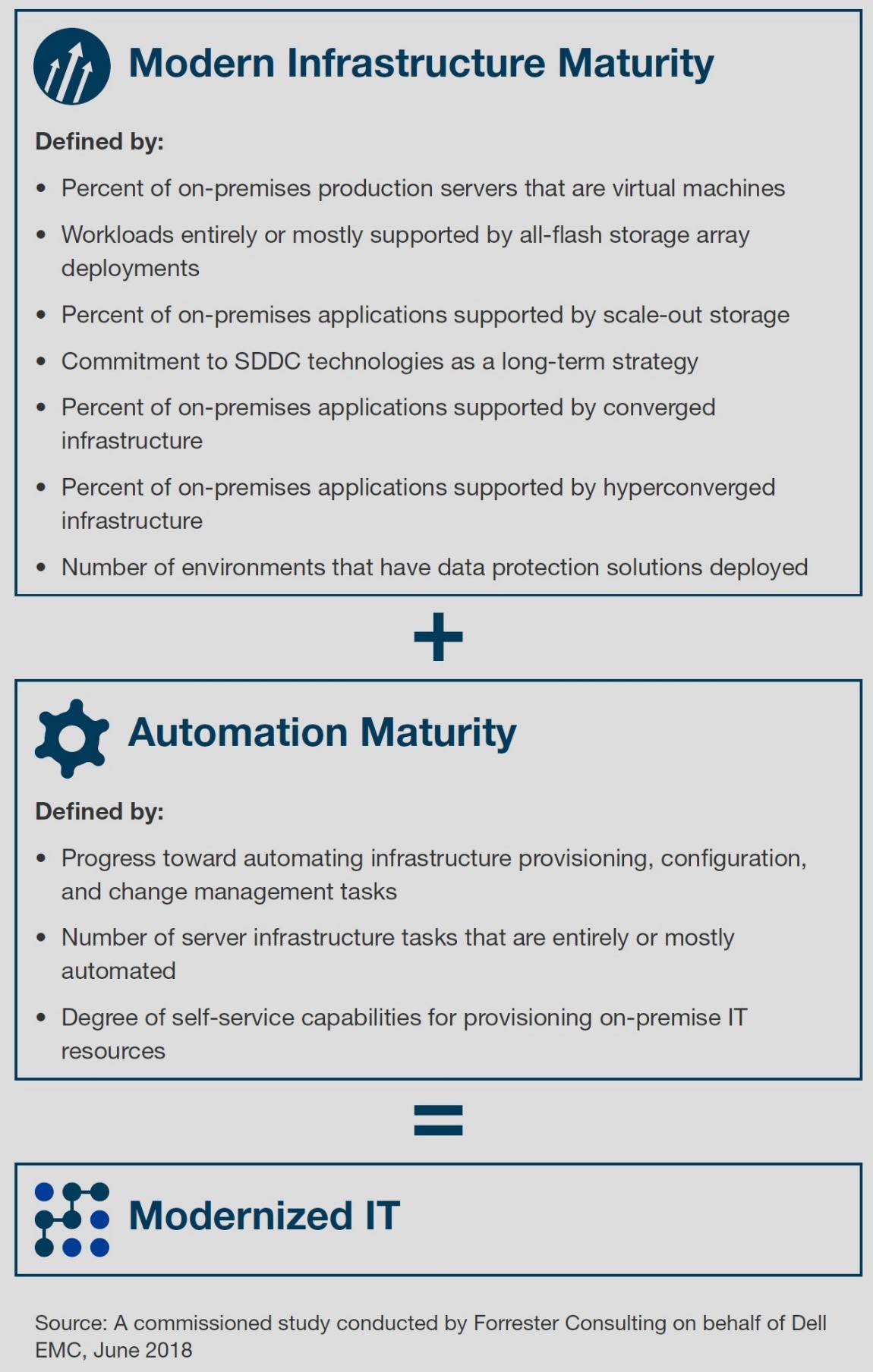In today’s age of digital disruption, one of the greatest challenges that companies face is the need to keep up with evolving technology. Speed and agility are key to a successful IT transformation, and organizations that can handle transformational workloads, such as artificial intelligence (AI) and cloud-native applications, have a significant advantage over those that can’t.
On one end of the spectrum are the innovative companies, with modern data center infrastructure and IT automation in place. On the other end are older businesses with slow, outdated process. A recent ESG study focused on the differences between them describes these two stages as “modernized” and “aging.”

One key difference between the two stages is that aging companies typically prioritize predictability and reliability, while modernized companies prioritize speed and agility. [1] In the past, IT departments were solely focused on traditional workloads like website, email, file, print, etc. They had to keep the basics up and running for the business to function. But the industry is shifting, and companies needs change as they move through their IT transformation. While reliability will always be important, the status quo is no longer enough. Today’s modernized companies must focus on speed and agility, so they can quickly process the enormous amounts of data that these transformational workloads require.
The same ESG study identified another key difference between modernized and aging companies: the use of modular servers in their infrastructure. ESG found that modular servers make up an average of 20% of a modernized company’s total server infrastructure, compared to only 5% in aging companies.1 That’s a significant difference, and plays a huge role in setting modernized companies apart from their aging counterparts.
How Modular Helps with Transformational Workloads
Because modernized companies favor speed and agility over predictability and reliability, they need to make sure they have modern data center infrastructure in place. New, data-intense workloads such as AI and ML have different hardware requirements. Modular servers can play a critical role here, because they are flexible, agile and easy to manage. Modernized companies understand this need, which is why so many already have a modular compute strategy in place.
How Does Modular Help with Transformational Workloads?
Modular infrastructure combines server, storage and networking – along with unified management software – so that users can easily tailor workloads and expand over time. It can meet the needs of both traditional and transformational workloads by providing the following benefits:
- Increased Scalability – Modular servers give you the flexibility to adjust resources to deliver the compute, storage, and network performance needed to accelerate both traditional and transformational workloads. In fact, an ESG study found that 57% of modular server users reported increased scalability benefits to the organization. 1
- Easier Management – Users can automate the management of compute, storage and networking resources with integrated, easy-to-use tools and spend less time on routine maintenance. Modular servers improved manageability for 50% of surveyed IT organizations. 1
- Faster Deployment – Modular infrastructure helps accelerate your time-to-value by quickly deploying traditional and transformational workloads. ESG found that the average benefit was a 35% reduction in deployment time among modernized organizations using modular. 1
- Improved Reliability – Users can adapt and respond with non-disruptive upgrades and minimal downtime. Modernized IT organizations are twice as likely as aging orgs to experience higher reliability with modular compute. 1
- Decreased OPEX – Modular is the original “pay as you grow” model, because it allows you to purchase only what you will use now, then add to it as your needs change. The average reduction in procurement costs by purchasing modular servers (compared to alternatives) was 32% among modernized organizations using modular. 1
Once an organization has the right infrastructure in place, it can more easily adopt transformational workloads. These innovative technologies help companies save time, increase productivity, decrease operating costs, and increase revenue. Meanwhile their competitors will be left further and further behind. Aging companies simply can’t offer the same services or customer experiences and ultimately run much less efficiently.

No matter what state of IT transformation your company is in, it’s worth considering whether modular servers can take your business to the next level. To learn more about modular infrastructure, read ESG’s full white paper Insights from Modernized IT: Modular Compute Can Have a Big Impact.
[1] Source: ESG White Paper Insights from Modernized IT: Modular Compute Can Have a Big Impact, commissioned by Dell EMC, August 2018